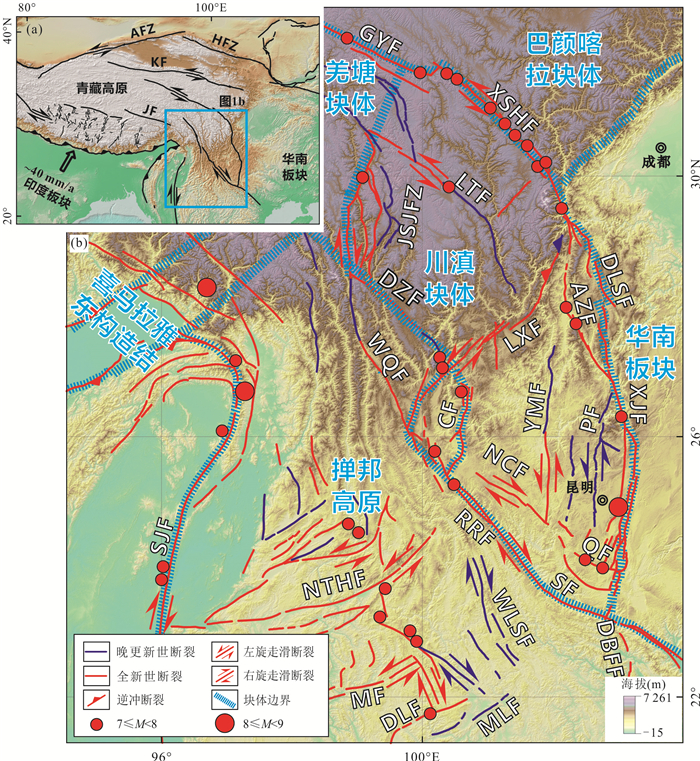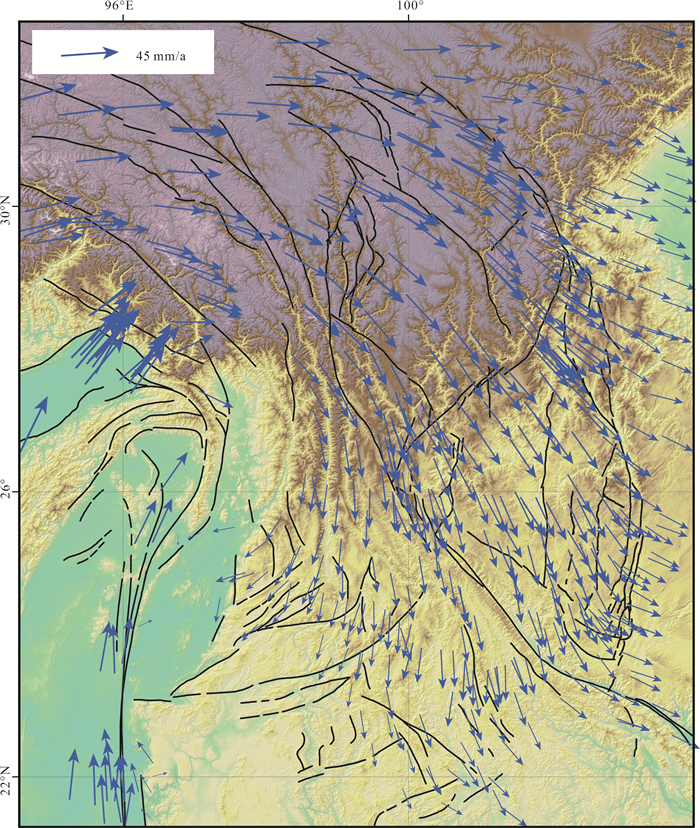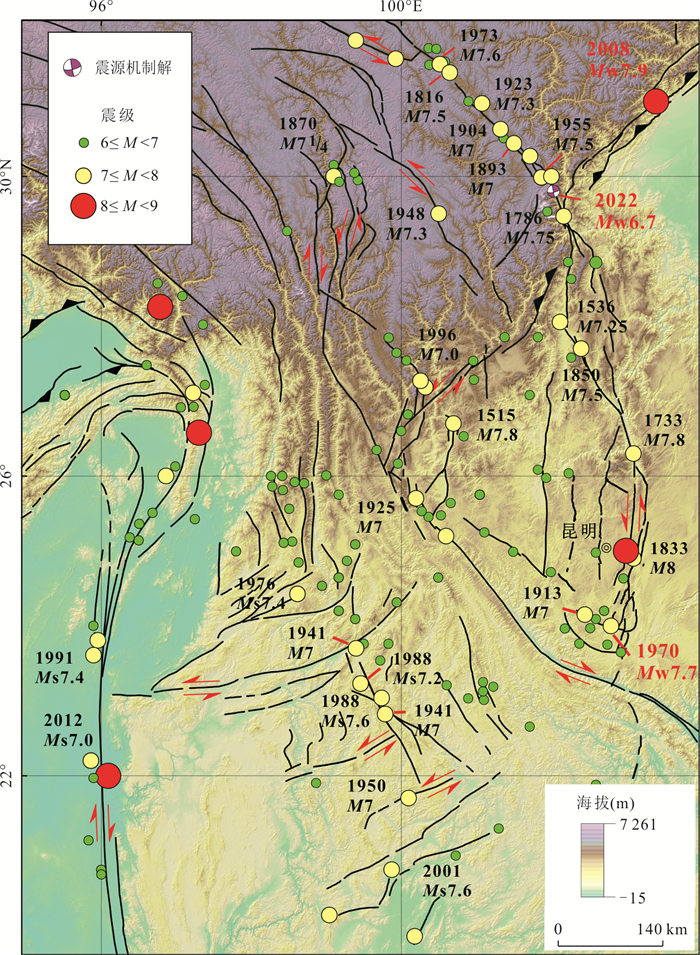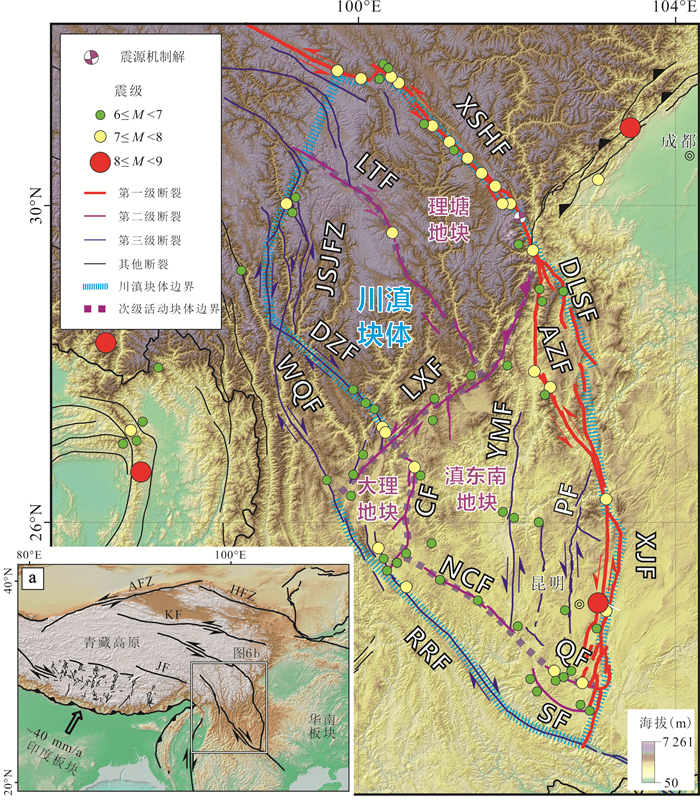Review of Structural Deformation in the Upper Crust of the Southeastern Margin of the Tibetan Plateau since the Late Cenozoic
-
摘要: 青藏高原东南缘是检验青藏高原演化模型的理想实验场,也是全球地震活动最为频繁的地区之一.综述了青藏高原东南缘主要活动断裂十年和万年尺度的滑动习性研究和百年时间尺度区域地震活动分布,结合前人总结的百万年时间尺度的年代学研究,认为自中新世中晚期以来,青藏高原内部物质逐渐向东流出,受四川盆地阻挡,转而向东南缘地区作顺时针旋转运动,至晚第四纪时期,东南缘地区上地壳变形已由原本集中分布在大型走滑边界断裂和逆冲褶皱带转变为弥散式分布至区内次级断裂,形成了以鲜水河-小江断裂带和实皆断裂带为边界,围绕喜马拉雅东构造结作顺时针旋转的运动学特征. 据此青藏高原东南缘变形可划分为两阶段,中新世早期及以前变形集中在大型边界断裂,符合刚性块体变形,至晚第四纪时期转为弥散式连续变形. 基于水平滑动速率和地震活动性对比,青藏高原东南缘活动断裂可大致分为三级. 一级断裂为边界断裂鲜水河-小江断裂带和实皆断裂带,水平滑动速率均≥10 mm/a,曾发生8级及以上地震和连续的7~7.9级强震,是东南缘地区晚第四纪以来一级构造格架;二级断裂往往控制东南缘地区强活动构造单元,水平滑动速率为~3~6 mm/a,通常发生过7~7.9级地震;三级断裂水平滑动速率一般≤2 mm/a,通常发生过7级以下地震,一般规模较小,但数量较多. 此外,川滇地块晚第四纪变形特征发生转变,构造运动由原本的沿大型边界走滑断裂运动转变为鲜水河-小江断裂带周缘次级活动地块的旋转、平移和差异隆升.Abstract: The southeastern margin of the Tibetan Plateau is an ideal experimental field to test the evolutionary model of the Tibetan Plateau and one of the most seismically active regions in the world. In this paper, we review the decadal and 10, 000⁃year⁃scale slip habits of the major active faults on the southeastern margin of the Tibetan Plateau and the 100⁃year⁃scale regional seismic activity, combined with the million⁃year time⁃scale chronology studies, we think the internal material of the Tibetan Plateau gradually flowed out to the east and was blocked by the Sichuan Basin, turning to the southeastern margin area for clockwise rotational movement since the middle and late Miocene. In the Late Quaternary, the upper crustal deformation in the southeastern margin has changed from being concentrated in large strike⁃slip boundary faults and thrust fold belts to being diffusely distributed to secondary faults in the region, forming the kinematic characteristics of clockwise rotation around the eastern Himalayan syntaxis with the Xianshuihe⁃Xiaojiang Fault Zone and the Sagaing Fault Zone as boundaries. Accordingly, the deformation of the southeastern margin of the Tibetan Plateau can be divided into two stages. The deformation of the early Miocene period was concentrated in large boundary faults, which conforms to the deformation of rigid blocks, and turned into diffuse continuous deformation in the late Quaternary. Based on the comparison of horizontal slip rate, seismogenic capacity and seismic activity, the active faults on the southeast edge of the Tibetan Plateau can be roughly divided into three levels. The first⁃tier faults are the boundary fault Xianshuihe⁃Xiaojiang fault zone and Sagaing fault zone, with horizontal slip rates ≥10 mm/a, capable of occurring earthquakes of M 8 and above alone, and can continuously generate strong earthquakes of M 7⁃7.9, which are the first⁃tier tectonic frame since the Late Quaternary in the southeastern margin; the second⁃tier faults can control the strongly active tectonic units in the southeast margin, with horizontal slip rates ~3⁃6 mm/a, generally capable of occurring earthquakes of M 7⁃7.9, and can continuously generate earthquakes of M 6⁃6.9; the horizontal slip rate of Level 3 faults is generally ≤2 mm/a, they are only capable to generating earthquakes less to M 7, and are generally smaller in scale but more numerous. In addition, the Late Quaternary deformation characteristics of the Chuandian Block have changed from the original slip movement along the large boundary faults to the rotation, translation and differential uplift of the secondary active blocks around the Xianshuihe⁃Xiaojiang Fault Zone.
-
图 1 (a) 研究区地理位置图; (b)青藏高原东南缘地质构造图
图a中:AFZ. 阿尔金断裂带;HFZ. 海原断裂带;KF. 东昆仑断裂;JF. 嘉黎断裂;图b中:GYF. 甘孜-玉树断裂;XSHF. 鲜水河断裂;AZF. 安宁河-则木河断裂带;DLSF. 大凉山断裂;XJF. 小江断裂;LTF. 理塘断裂;JSJFZ. 金沙江断裂;WQF. 维西-乔后断裂;LXF. 丽江-小金河断裂;DZF. 德钦-中甸断裂;CF. 程海断裂;NCF. 南华-楚雄断裂;YMF. 元谋断裂;QF. 曲江断裂;SF. 石屏-建水断裂;PF. 普渡河断裂;DBFF. 奠边府断裂;RRF. 红河断裂;NTHF. 南汀河断裂;MF. 勐连断裂;MLF. 勐龙断裂;DLF. 打洛断裂;SJF. 实皆断裂;块体划分依据张培震等(2013)
Fig. 1. (a)Geographical location map of the study area; (b) Tectonic map of southeast margin of the Tibetan Plateau
图 2 青藏高原东南缘GNSS观测的地壳运动速度场(所有GNSS速度均相对于稳定的欧亚大陆,数据来自Wang and Shen, 2020)
Fig. 2. Velocity field of crustalde formation of the southeast margin of the Tibetan Plateau observed from Global Navigation Satellite System(All GNSS velocities are in Eurasian fixed reference frame, data from Wang and Shen, 2020)
图 6 (a) 川滇块体地理位置图; (b)川滇块体断裂分级和强震分布图
AFZ. 阿尔金断裂带;HFZ. 海原断裂带;KF. 东昆仑断裂;JF. 嘉黎断裂. b:青藏高原东南缘地质构造图. XSHF. 鲜水河断裂;AZF. 安宁河-则木河断裂带;DLSF. 大凉山断裂;XJF. 小江断裂;LTF. 理塘断裂;JSJFZ. 金沙江断裂;WQF. 维西-乔后断裂;LXF. 丽江-小金河断裂;DZF. 德钦-中甸断裂;CF. 程海断裂;NCF. 南华-楚雄断裂;YMF. 元谋断裂;QF. 曲江断裂;SF. 石屏-建水断裂;PF. 普渡河断裂;RRF. 红河断裂
Fig. 6. (a)Geographical location map of the Chuandian block; (b)Classification of fault slip rate and strong earthquake distribution map of the Chuandian block
表 1 青藏高原东南缘断裂现今水平滑动速率
Table 1. Current horizontal slip rate of faults in the southeastern margin of the Tibetan Plateau

表 2 鲜水河-小江断裂带晚第四纪水平滑动速率
Table 2. Late Quaternary horizontal slip rate of the Xianshuihe⁃Xiaojiang fault zone
断裂名称 位置 位错标志体 位错量 测年方式 测年结果 水平滑动速率(mm/a) 参考文献 鲜水河断裂 北西段 磨西盆地 阶地面冲沟位错 Ta冲沟:(46±8) m;Tb冲沟位错:(28±5) m TL Ta:(5 215±125) a;
Tb:(2 925±85) a9.6±1.7 徐锡伟等(2003) Douri 冲沟位错 1 800 m (172.20±18.94) ka 11.09±1.22 Zhang et al. (2016) Kaqi 2 100 m (191.65±21.08) ka 10.58±1.16 Kasu 212 m (21 300±1 150) a 9.98±0.54 226 m 10.64±0.57 210 m 9.89±0.53 龙灯坝 河流阶地位错 242 m T3:(23.3±2.0) ka;
T2:(13.18±1.07) ka17±3 Chen et al. (2016) 炉霍故里村 T2/T3
(55±10) mT3:(7.32±0.56) ka;T2:(3.76±0.29) ka 14±2 徐锡伟等(2003) 道孚麻孜村 河谷位错 (400±50) m 河谷底部堆积物:(27.24±2.12) ka 道孚松林口 河流阶地位错 T3/T2
(170.5±15) mT2:(13.18±1.07) ka 色拉哈段 Tagong 冰碛物位错 (96±20) m 10Be 12.5(+2.5~2.2) ka 7.6(+2.3~1.9) Bai et al. (2018) 色拉哈 (240±15) m (22±2) ka 10.7(+1.3~1.1) 杨家沟 (80±5) m (18±2) ka 9.6~9.9 Jin longsi 河流阶地位错 75 m 14C (7 095±131) a.B.P. 6.7±3 Chen et al. (2016) 折多塘段 折多塘 冲沟位错 142 m OSL (16.4±1.3) ka 8.5±2 Chen et al. (2016) 折多塘 冰碛物位错 (65±10) m 10Be (12.7±1.0)~(15.9±1.2) ka 4.1±0.7 Bai et al. (2021) 磨西段 磨西 冰碛物位错 (205±30) m 10Be (18±1.4) ka 11.4(+2.0/-1.8) Bai et al. (2021) 安宁河断裂 冕宁林里村 冲沟位错 (180±30) m TL T3:(31±1.9) ka;
T2:(25.35±0.41) ka6.5±1 徐锡伟等(2003) 大水沟 河流阶地位错 T1: (5.3±0.3) m;T3/T2: (15.0±0.5) m 14C T1:(920±30) a、(1 130±30) a;T3:(3 330±30) a、(3 240±30) a、(3 350±30) a 4.4 王虎等(2018) 沙尔盆地 洪积扇冲沟位错和冲沟阶地位错 冲沟: 27.5 m阶地: 6 m TL 洪积扇顶部粘土质粉砂:(4.1±0.3) ka;冲沟阶地:(2.06±0.16) ka 3~7 何宏林和池田隆安(2007) 紫马跨 台地冲沟位错 (84±3) m 14C 断塞塘底部腐殖质:2.0~2.2 ka 4.2±0.2 冉勇康等(2008) 马家沟 洪积扇边缘位错 (23±2) m 断塞塘底部
(3 100±30) a.B.P.7.4±0.7 Hu et al. (2021) 则木河断裂 西昌 洪积扇位错 (85±5) m TL (13.29±1.04) ka 6.4±0.6 徐锡伟等(2003) 五道菁乡 洪积扇边缘位错 76 m 14C (15 630±990) a 4.9 任金卫(1994) Sijiabushi 台地面冲沟 85 m TL14C古气候 10~15 ka 5.7~8.5 He et al. (2008) Lanbiluo 72~88 m 10~15 ka 4.8~8.8 Dalouhe 80~90 m 10~15 ka 5.3~9.0 Tuomugou 80 m 10~15 ka 5.3~8.0 大凉山断裂 拖都以西 阶地位错 (60±5) m
(40±4) m
(30±4) m14C (14.74±0.15) ka 3.3±0.3 徐锡伟等(2003) 曲古地 洪积扇上冲沟位错 28 m TL (24 980±1 950) a. B.P. 2.6 周荣军等(2003) 布拖 洪积扇上冲沟位错 37 m (13 170±130) a. B.P. 2.8 吉夫拉打乡 洪积扇上冲沟位错 50 m (17 760±1 400) a. B.P. 2.8 则左青村 洪积扇上冲沟位错 (7.6±0.2) m OSL (2.6±0.2) ka 2.9±0.24 魏占玉等(2012) 洛达村 河道位错 (95±0.5) m (37.1±3.2) ka 2.6±0.24 觉撒乡 洪积扇上河道位错 (20.4±0.5) m (8.1±0.4) ka 2.5±0.13 小江断裂带 Cangxi 台地面冲沟位错 65 m TL 14C
古气候6~7 ka 9.3~10.8 He et al(2008) Laoxiajia 120 m 10~15 ka 8~12 白龙潭 102 m 10~15ka 6.7~10.0 注:14C. 放射性碳测年;OSL. 光释光测年;TL. 热释光测年. 表 3 二级和三级断裂晚第四纪水平滑动速率
Table 3. Late Quaternary horizontal slip rate of Level 2 and 3 faults
二级断裂 断裂名称 位置 位错标志体 位错量 测年方式 测年结果 水平滑动速率(mm/a) 参考文献 丽江-小金河断裂 南溪担读村 洪积扇冲沟 (31±4) m 14C (9 910±210) a 3.1±0.4 徐锡伟等(2003) 丽江盆地莲花村 洪积扇冲沟 8.6 m (2 950±115) a、(1 905±95) a 4.5±0.2 尖山营 冲沟阶地 (24.7±1.5) m (7 460±60) cal B.P. 3.32±0.22 郜宇等(2019) 理塘断裂 理塘县金厂沟口 冲沟阶地 (20±4) m TL (6.41±0.51) ka 4±1 徐锡伟等(2003) 曲江断裂 断裂沿线冲沟 冲沟位错 3.7~830 m 侵蚀速率估算 2.3~4 王洋等(2015) 三级断裂 断裂名称 位置 位错标志体 位错量 测年方式 测年结果 水平滑动速率(mm/a) 参考文献 红河断裂 Diduo村 冲沟位错 56~64 m 14C 44 279 cal a B.P. 1.45 Shi et al. (2018b) 注:14C. 放射性碳测年;TL. 热释光测年. -
Akciz, O. S., 2004. Structure and Geochronological Constraints on the Ductile Deformation Observed along the Gaoligong Shan and Chong Shan Shear Zones, Yunnan (China)(Dissertation). Massachusetts Institute of Technology, Cambridge. Allen, C. R., Gillespie, A. R., Han, Y., et al., 1984. Red River and Associated Faults, Yunnan Province, China: Quaternary Geology, Slip Rates, and Seismic Hazard. Geological Society of America Bulletin, 95(6): 686. https://doi.org/10.1130/0016⁃7606(1984)95686: rraafy>2.0.co;2 doi: 10.1130/0016⁃7606(1984)95686:rraafy>2.0.co;2 An, Z., Zhang, P., Wang, E., et al., 2006. Changes of the Monsoon⁃Arid Environment in China and Growth of the Tibetan Plateau Since the Miocene. Quaternary Sciences, 26(5): 1-16 (in Chinese with English abstract). Avouac, J. P., Tapponnier, P., 1993. Kinematic Model of Active Deformation in Central Asia. Geophysical Research Letters, 20(10): 895-898. https://doi.org/10.1029/93gl00128 Bai, M. K., Chevalier, M. L., Leloup, P. H., et al., 2021. Spatial Slip Rate Distribution along the SE Xianshuihe Fault, Eastern Tibet, and Earthquake Hazard Assessment. Tectonics, 40(11): e2021TC006985. https://doi.org/10.1029/2021tc006985 Bai, M., Chevalier, M. L., Pan, J., et al., 2018. Southeastward Increase of the Late Quaternary Slip⁃Rate of the Xianshuihe Fault, Eastern Tibet, Geodynamic and Seismic Hazard Implications. Earth and Planetary Science Letters, 485: 19-31. https://doi.org/10.1016/j.epsl.2017.12.045. Chang, Y., Chen, L., Zhang, Q., 2019. Study on the Tectonic Landform and Fault Activity Characteristics of the Jinsha River Fault Zone. International Earthquake Dynamics, 8 (13): 142-143 (in Chinese). Chen, G. F., Bartholomew, M., Liu, D. M., et al., 2022. Paleo-Earthquakes along the Zheduotang Fault, Xianshuihe Fault System, Eastern Tibet: Implications for Seismic Hazard Evaluation. Journal of Earth Science, 33(5): 1233-1245. https://doi.org/10.1007/s12583⁃022⁃1687⁃0 Chen, G., Xu, X., Wen, X., et al. 2016. Late Quaternary Slip⁃Rates and Slip⁃Partitioning on the Southeastern Xianshuihe Fault System, Eastern Tibetan Plateau. Acta Geologica Sinica (English Edition), 90: 537-554. https://doi.org/10.1111/1755⁃6724.12689 Deng, J., Wang, Q. F., Li, G. J., et al., 2014. Cenozoic Tectono⁃Magmatic and Metallogenic Processes in the Sanjiang Region, Southwestern China. Earth⁃Science Reviews, 138: 268-299. https://doi.org/10.1016/j.earscirev.2014.05.015 Deng, Q., Zhang, P., Ran, Y., et al., 2002. Basic Characteristics of Activity Structure in Mainland China. Chinese Science: Earth Science, 32: 1020-1030(in Chinese with English abstract). Department of Earthquake Disaster Prevention, China Earthquake Administration, 1995. Catalogue of Strong Earthquakes in Chinese History: 23rd Century BC~1911 AD. Seismological Press, Beijing(in Chinese). Department of Earthquake Disaster Prevention, China Earthquake Administration, 1999. Catalogue of Modern Earthquakes in China: AD 1912—1990, Ms≥4.7. China Science and Technology Press, Beijing (in Chinese). England, P., Houseman, G., 1986. Finite Strain Calculations of Continental Deformation: 2. Comparison with the India⁃Asia Collision Zone. Journal of Geophysical Research: Solid Earth, 91(B3): 3664-3676. https://doi.org/10.1029/jb091ib03p03664 England, P., Houseman, G., 1988. The Mechanics of the Tibetan Plateau. Philosophical Transactions of the Royal Society of London Series A, Mathematical and Physical Sciences, 326(1589): 301-320. https://doi.org/10.1098/rsta.1988.0089 Fan, C., Wang, G., Wang, S. F., et al., 2006. Structural Interpretation of Extensional Deformation along the Dali Fault System, Southeastern Margin of the Tibetan Plateau. International Geology Review, 48(4): 287-310. https://doi.org/10.2747/0020⁃6814.48.4.287 Flesch, L. M., Haines, A. J., Holt, W. E., 2001. Dynamics of the India⁃Eurasia Collision Zone. Journal of Geophysical Research: Solid Earth, 106(B8): 16435-16460. https://doi.org/10.1029/2001jb000208 Gan, W. J., Zhang, P. Z., Shen, Z. K., et al., 2007. Present⁃Day Crustal Motion within the Tibetan Plateau Inferred from GPS Measurements. Journal of Geophysical Research: Solid Earth, 112(B8): B08416. https://doi.org/10.1029/2005jb004120 Gan, W., Molnar, P., Zhang, P., et al., 2021. Initiation of Clockwise Rotation and Eastward Transport of Southeastern Tibet Inferred from Deflected Fault Traces and GPS Observations. Geological Society of America Bulletin, (5/6): 134. https://doi.org/10.1130/B36069.1 Gao, Y., Ding, R., Zhang, S., et al., 2019. Slip Rate of Lijiang⁃Xiaojinhe Fault in the Holocene. Technology for Earthquake Disaster Prevention, (3): 617-627(in Chinese with English abstract). He, H., Oguchi, T., 2008. Late Quaternary Activity of the Zemuhe and Xiaojiang Faults in Southwest China from Geomorphological Mapping. Geomorphology, 96(1/2): 62-85. https://doi.org/10.1016/j.geomorph.2007.07.009 He, H., Yasutakyr, I., 2007. Faulting on the Anninghe Fault Zone, Southwest China in Late Quaternary and Its Movement Model. Acta Seismologica Sinica, 29(5): 537-548 (in Chinese with English abstract). He, Y., Zhou, R., Li, X., et al., 2001. Seismic Rupture and Source Stress Field of Gengma M7.2 Earthquake in Yunnan Province. North China Earthquake Sciences, 19(2): 21-26 (in Chinese with English abstract). Hu, M., Wu, Z., Li, J., et al. 2021. Late Quaternary Left⁃Lateral Strike Slip Rate along the Anninghe⁃Zemuhe Section of the Xianshuihe⁃Xiaojiang Fault System and Its Implication to the Clockwise Block Rotation of the SE Margin of the Tibetan Plateau. Geochemistry, Geophysics, Geosystems, https://doi.org/10.1002/essoar.10505860.2. Institute of Geology, State Seismological Administration and Seismological Administration of Yunnan Province, 1990. Active Faults in Northwest Yunnan. Seismological Press, Beijing (in Chinese). Jiao, L. Q., Tapponnier, P., Donzé, F. V., et al., 2023. Discrete Element Modeling of Southeast Asia's 3D Lithospheric Deformation during the Indian Collision. Journal of Geophysical Research: Solid Earth, 128(1): e2022JB025578. https://doi.org/10.1029/2022jb025578 Lacassin, R., Replumaz, A., Hervé Leloup, P., 1998. Hairpin River Loops and Slip⁃Sense Inversion on Southeast Asian Strike⁃Slip Faults. Geology, 26(8): 703. https://doi.org/10.1130/0091⁃7613(1998)0260703: hrlass>2.3.co;2 doi: 10.1130/0091⁃7613(1998)0260703:hrlass>2.3.co;2 Leloup, P. H., Arnaud, N., Lacassin, R., et al., 2001. New Constraints on the Structure, Thermochronology, and Timing of the Ailao Shan⁃Red River Shear Zone, SE Asia. Journal of Geophysical Research: Solid Earth, 106(B4): 6683-6732. https://doi.org/10.1029/2000jb900322 Leloup, P. H., Harrison, T. M., Ryerson, F. J., et al., 1993. Structural, Petrological and Thermal Evolution of a Tertiary Ductile Strike⁃Slip Shear Zone, Diancang Shan, Yunnan. Journal of Geophysical Research: Solid Earth, 98(B4): 6715-6743. https://doi.org/10.1029/92jb02791 Leloup, P. H., Lacassin, R., Tapponnier, P., et al., 1995. The Ailao Shan⁃Red River Shear Zone (Yunnan, China), Tertiary Transform Boundary of Indochina. Tectonophysics, 251(1/2/3/4): 3-84. https://doi.org/10.1016/0040⁃1951(95)00070⁃4 Leloup, P. H., Tapponnier, P., Lacassin, R., et al., 2007. Discussion on the Role of the Red River Shear Zone, Yunnan and Vietnam, in the Continental Extrusion of SE Asia. Journal of the Geological Society, 164(6): 1253-1260. https://doi.org/10.1144/0016⁃76492007⁃065 Li, C., Wang, Y., Gan, W., et al., 2020. Diffuse deformation in the SE Tibetan Plateau: New Insights from Geodetic Observations. Journal of Geophysical Research: Solid Earth, 125: e2020JB019383. https://doi.org/10.1029/2020JB019383 Liu⁃Zeng, J., Tapponnier, P., Gaudemer, Y., et al., 2008. Quantifying Landscape Differences across the Tibetan Plateau: Implications for Topographic Relief Evolution. Journal of Geophysical Research: Earth Surface, 113(F4): F04018. https://doi.org/10.1029/2007jf000897 Mitchell, A. H. G., 1993. Cretaceous⁃Cenozoic Tectonic Events in the Western Myanmar (Burma)⁃Assam Region. Journal of the Geological Society, 150(6): 1089-1102. https://doi.org/10.1144/gsjgs.150.6.1089 Peltzer, G., Tapponnier, P., 1988. Formation and Evolution of Strike⁃Slip Faults, Rifts, and Basins during India⁃Asia Collision: an Experiment Approach. Journal of Geophysical Research, 93: 15085-15117. https://doi.org/10.1029/JB093iB12p15085 Ran, Y., Cheng, J., Gong, H., et al., 2008. Late Quaternary Geomorphic Deformation and Displacement Rates of the Anninghe Fault around Zimakua. Seismology and Geology, 30 (1): 86-98(in Chinese with English abstract). Ren, J., 1994. Late Quaternary Displacement and Slip Rate of Zemuhe Fault in Sichuan, China. Seismology and Geology, 16(2): 146(in Chinese with English abstract). Replumaz, A., Lacassin, R., Tapponnier, P., et al., 2001. Large River Offsets and Plio⁃Quaternary Dextral Slip Rate on the Red River Fault (Yunnan, China). Journal of Geophysical Research: Solid Earth, 106(B1): 819-836. https://doi.org/10.1029/2000jb900135 Schoenbohm, L. M., Burchfiel, B. C., Chen, L. Z., 2006b. Propagation of Surface Uplift, Lower Crustal Flow, and Cenozoic Tectonics of the Southeast Margin of the Tibetan Plateau. Geology, 34(10): 813. https://doi.org/10.1130/g22679.1 Schoenbohm, L. M., Burchfiel, B. C., Liangzhong, C., et al., 2006a. Miocene to Present Activity along the Red River Fault, China, in the Context of Continental Extrusion, Upper⁃Crustal Rotation, and Lower⁃Crustal Flow. Geological Society of America Bulletin, 118(5/6): 672-688. https://doi.org/10.1130/b25816.1 Searle, M. P., Noble, S. R., Cottle, J. M., et al., 2007. Tectonic Evolution of the Mogok Metamorphic Belt, Burma (Myanmar) Constrained by U⁃Th⁃Pb Dating of Metamorphic and Magmatic Rocks. Tectonics, 26(3): TC3014. https://doi.org/10.1029/2006tc002083 Shen, Z. K., Lü, J. N., Wang, M., et al., 2005. Contemporary Crustal Deformation around the Southeast Borderland of the Tibetan Plateau. Journal of Geophysical Research: Solid Earth, 110(B11): 409. https://doi.org/10.1029/2004jb003421 Shi, X. H., Wang, Y., Sieh, K., et al., 2018a. Fault Slip and GPS Velocities across the Shan Plateau Define a Curved Southwestward Crustal Motion around the Eastern Himalayan Syntaxis. Journal of Geophysical Research: Solid Earth, 123(3): 2502-2518. https://doi.org/10.1002/2017jb015206 Shi, X. H., Sieh, K., Weldon, R., et al., 2018b. Slip Rate and Rare Large Prehistoric Earthquakes of the Red River Fault, Southwestern China. Geochemistry, Geophysics, Geosystems, 19(7): 2014-2031. https://doi.org/10.1029/2017gc007420 Tapponnier, P., Lacassin, R., Leloup, P. H., et al., 1990. The Ailao Shan/Red River Metamorphic Belt: Tertiary Left⁃Lateral Shear between Indochina and South China. Nature, 343(6257): 431-437. https://doi.org/10.1038/343431a0 Tin, T., Nishimura, T., Hashimoto, M., et al. 2022. Present⁃Day Crustal Deformation and Slip Rate along the Southern Sagaing Fault in Myanmar by GNSS Observation. Journal of Asian Earth Sciences, 228: 105125. https://doi.org/10.1016/j.jseaes.2022.105125 Wang, D., Dong, Y., Jiao, Q., et al., 2022. The Mechanism of Tectonic Deformation of the Central Yunnan Terrane in the Late Cenozoic Based on Tectonic Geomorphology. Earth Science, 47(8): 3016-3028(in Chinese with English abstract). Wang, E., Kirby, E., Furlong, K. P., et al., 2013. Two⁃Phase Growth of High Topography in Eastern Tibet during the Cenozoic. Nature Geoscience, 5(9): 640-645. https://doi.org/10.1038/ngeo1538 Wang, H., Ran, Y., Chen, L., et al., 2018. Determination of Slip Rate on the Southern Segment of the Anninghe Fault. Seismology and Geology, 40 (5): 967-979 (in Chinese with English abstract). Wang, H., Yang, Z. Y., Jing, L. Z., et al., 2023. Tectonic Rotation Pattern at the Northern End of the Red River Fault System in SE Tibet: New Paleomagnetic Evidence from Cretaceous Red Beds. Tectonics, 42(3): e2021TC007116. https://doi.org/10.1029/2021tc007116 Wang, M., Shen, Z. K., 2020. Present⁃Day Crustal Deformation of Continental China Derived from GPS and Its Tectonic Implications. Journal of Geophysical Research: Solid Earth, 125(2): e2019JB018774. https://doi.org/10.1029/2019jb018774 Wang, Y., Sieh, K., Tun, S., et al., 2014. Active Tectonics and Earthquake Potential of the Myanmar Region. Journal of Geophysical Research: Solid Earth, 119: 3767-3822. https://doi.org/10.1002/2013JB010762 Wang, Y., Wang, E., Shen, Z., et al., 2008. Inversion of Current Activity Rates of Major Faults in Sichuan⁃Yunnan Region Based on GPS Data Constraints. Science China Earth Sciences, 38(5): 582-597 (in Chinese with English abstract). Wang, Y., Wang, Y. J., Zhang, P. Z., et al., 2019. Intracontinental Deformation within the India⁃Eurasia Oblique Convergence Zone: Case Studies on the Nantinghe and Dayingjiang Faults. GSA Bulletin, 132(3/4): 850-862. https://doi.org/10.1130/b35338.1 Wang, Y., Zhang, B., Hou, J., et al., 2015. Late Quaternary Activity of the Qujiang Fault and Analysis of the Slip Rate. Seismology and Geology, 37 (4): 1177-1192(in Chinese with English abstract). Wei, Z., He, H., Shi, F., et al., 2012. Slip Rate on the South Segment of Daliangshan Fault zone. Seismology and Geology, 34(2): 282-293 (in Chinese with English abstract). Xu, X., Wen, X., Zheng, R., et al., 2003. Newly Tectonic Deformation and its Dynamic Source of the Sichuan⁃Yunnan Block. Science in China (Ser D), 33(4): 151-162(in Chinese with English abstract). Xu, Z., Yang, J., Li, H., et al., 2011. On the Tectonics of the India⁃Asia Collision. Acta Geologica Sinica, (1): 1-33(in Chinese with English abstract). Yin, A., Harrison, T. M., 2000. Geologic Evolution of the Himalayan⁃Tibetan Orogen. Annual Review of Earth and Planetary Sciences, 28: 211-280. https://doi.org/10.1146/annurev.earth.28.1.211 Zhang, B., Zhang, J., Zhong, D., 2010. Structure, Kinematics and Ages of Transpression during Strain⁃Partitioning in the Chongshan Shear Zone, Western Yunnan, China. Journal of Structural Geology, 32(4): 445-463. https://doi.org/10.1016/j.jsg.2010.02.001 Zhang, B., Zhang, J., Zhong, D., et al., 2012. Poly Stage Deformation of the Gaoligong Metamorphic Zone: Structures, 40Ar/39Ar Mica Ages, and Tectonic Implications. Journal of Structural Geology, 37: 1-18. https://doi.org/10.1016/j.jsg.2012.02.007 Zhang, G., Tian, Y., Li, R., et al, . 2022. Progressive Tectonic Evolution from Crustal Shortening to Mid⁃Lower Crustal Expansion in the Southeast Tibetan Plateau: A Synthesis of Structural and Thermochronological Insights. Earth⁃Science Reviews, 226: 103951. https://doi.org/10.1016/j.earscirev.2022.103951 Zhang, G., Zhang, P., 2000. Medium⁃Term Academic Progress of "Mechanism and Prediction of Strong Earthquakes in Mainland". Basic Science in China, 10: 4-10 (in Chinese). Zhang, P., Deng, Q., Zhang, G., et al., 2003. Strong Earthquake Activity and Active Blocks in Mainland China. China Science Series D: Earth Science, 33 (Supplement): 12-20 (in Chinese). Zhang, P., Deng, Q., Zhang, Z., et al., 2013. Active Faults, Earthquake Hazards and Associated Geodynamic Processes in Continental China. Scientia Sinica Terrae, 43(10): 1607-1620 (in Chinese with English abstract). doi: 10.1360/zd-2013-43-10-1607 Zhang, P., Shen, Z, Wang, M, et al., 2004. Continuous Deformation of the Tibetan Plateau from Global Positioning System Data. Geology, 32(9): 809-812. https://doi.org/10.1130/G20554.1 Zhang, P., Wang, W., Gan, W., et al. 2022. Present⁃Day Deformation and Geodynamic Processes of the Tibetan Plateau. Acta Geologica Sinica, 96(10): 3297-3313. (in Chinese with English abstract). Zhang, Y., Yao, X., Yu, K., et al. 2016. Late Quaternary Slip-Rate and Seismic Activity of the Xianshuihe Fault Zone in Southwest China. Acta Geologica Sinica (English Edition). 90: 525-536. https://doi.org/10.1111/1755⁃6724.12688 Zhou, R., Ma, S., Cai, C., 1996. Late Quaternary Active Features of the Ganzi⁃Yushu Fault Zone. Earthquake Research in China, 12(3): 250-260(in Chinese with English abstract). Zhu, L., 2020. Numerical Simulation of Crustal Deformation Dynamics in the Southeastern Margin of the Tibetan Plateau(Dissertation). Institute of Geology, China Earthquake Administration, Beijing (in Chinese with English abstract). 安芷生, 张培震, 王二七, 等, 2006. 中新世以来我国季风-干旱环境演化与青藏高原的生长. 第四纪研究, 26(5): 1-16. https://www.cnki.com.cn/Article/CJFDTOTAL-DSJJ200605001.htm 常玉巧, 陈立春, 张琦, 2019. 金沙江断裂带构造地貌与断裂活动特征研究. 国际地震动态, 8(13): 142-143. https://www.cnki.com.cn/Article/CJFDTOTAL-GJZT201908115.htm 邓起东, 张培震, 冉勇康, 等, 2002. 中国大陆活动构造基本特征. 中国科学D辑: 地球科学, 32: 1020-1030. https://www.cnki.com.cn/Article/CJFDTOTAL-DZLX201905007.htm 郜宇, 丁锐, 张世民, 等, 2019. 丽江-小金河断裂全新世滑动速率研究. 震灾防御技术, (3): 617-627. https://www.cnki.com.cn/Article/CJFDTOTAL-ZZFY201903014.htm 国家地震局地质研究所和云南省地震局, 1990. 滇西北地区活动断裂. 北京: 地震出版社. 何宏林, 池田安隆, 2007. 安宁河断裂带晚第四纪运动特征及模式的讨论. 地震学报, 29(5): 537-548. https://www.cnki.com.cn/Article/CJFDTOTAL-DZXB200705012.htm 何玉林, 周荣军, 黎小刚, 等, 2001. 云南耿马7.2级地震破裂与震源应力场. 华北地震科学, 19(2): 21-26. https://www.cnki.com.cn/Article/CJFDTOTAL-HDKD200102003.htm 冉勇康, 程建武, 宫会玲, 等, 2008. 安宁河断裂紫马跨一带晚第四纪地貌变形与断层位移速率. 地震地质, 30(1): 86-98. https://www.cnki.com.cn/Article/CJFDTOTAL-DZDZ200801006.htm 任金卫, 1994. 则木河断裂晚第四纪位移及滑动速率. 地震地质, 16(2): 146. https://www.cnki.com.cn/Article/CJFDTOTAL-DZDZ402.006.htm 邵志刚, 冯蔚, 王芃, 等, 2020. 中国大陆活动地块边界带的地震活动特征研究综述. 地震地质, 42(2): 271-282. https://www.cnki.com.cn/Article/CJFDTOTAL-DZDZ202002003.htm 王丹, 董有浦, 焦骞骞, 等, 2022. 滇中地块新生代晚期的变形机制: 基于构造地貌学分析. 地球科学, 47(8): 3016-3028. doi: 10.3799/dqkx.2021.146 王虎, 冉永康, 陈立春, 等, 2018. 安宁河断裂带南段滑动速率估计. 地震地质, 40(5): 967-979. https://www.cnki.com.cn/Article/CJFDTOTAL-DZDZ201805003.htm 王阎昭, 王恩宁, 沈正康, 等, 2008. 基于GPS资料约束反演川滇地区主要断裂现今活动速率. 中国科学D辑: 地球科学, 38(5): 582-597. https://www.cnki.com.cn/Article/CJFDTOTAL-JDXK200805006.htm 王洋, 王岳军, 张培震, 等, 2022. 青藏高原东南缘断裂体系新生代构造演化. 中国科学: 地球科学, 52(5): 777-802. https://www.cnki.com.cn/Article/CJFDTOTAL-JDXK202205001.htm 王洋, 张波, 侯建军, 等, 2015. 曲江断裂晚第四纪活动特征及滑动速率分析. 地震地质, 37(4): 1177-1192. https://www.cnki.com.cn/Article/CJFDTOTAL-DZDZ201504019.htm 魏占玉, 何宏林, 石峰等, 2012. 大凉山断裂带南段滑动速率估计. 地震地质, 34(2): 282-293. https://www.cnki.com.cn/Article/CJFDTOTAL-DZDZ201202008.htm 徐锡伟, 闻学泽, 郑荣章等. 2003. 川滇地区活动地块最新构造变动样式及其动力来源. 中国科学: D辑, 33(4): 151-162. https://www.cnki.com.cn/Article/CJFDTOTAL-JDXK2003S1016.htm 许志琴, 杨经绥, 李海兵, 等, 2011. 印度-亚洲碰撞大地构造. 地质学报(1): 1-33. https://www.cnki.com.cn/Article/CJFDTOTAL-DZXE201101001.htm 张国民, 张培震, 2000. "大陆强震机理与预测"中期学术进展. 中国基础科学, 10: 4-10 https://www.cnki.com.cn/Article/CJFDTOTAL-ZGJB200010000.htm 张培震, 邓起东, 张国民, 等, 2003. 中国大陆强震活动与活动地块. 中国科学D辑: 地球科学, 33(增刊): 12-20. https://www.cnki.com.cn/Article/CJFDTOTAL-JDXK200407000.htm 张培震, 邓起东, 张竹琪, 等, 2013. 中国大陆的活动断裂、地震灾害及其动力过程. 中国科学: 地球科学, 43(10): 1607-1620. https://www.cnki.com.cn/Article/CJFDTOTAL-JDXK201310005.htm 张培震, 王伟涛, 甘卫军, 等, 2022. 青藏高原的现今构造变形与地球动力过程. 地质学报, 96(10): 3297-3313. https://www.cnki.com.cn/Article/CJFDTOTAL-DZXE202210002.htm 中国地震局震害防御司, 1995. 中国历史强震目录: 公元前23世纪—公元1911年. 北京: 地震出版社. 中国地震局震害防御司, 1999. 中国近代地震目录: 公元1912年—1990年, Ms≥4.7. 北京: 中国科学技术出版社. 周荣军, 黎小刚, 黄祖智, 等, 2003. 四川大凉山断裂带的晚第四纪平均滑动速率. 地震研究, 26 (2): 191-196. https://www.cnki.com.cn/Article/CJFDTOTAL-DZYJ200302013.htm 朱良玉, 2020. 青藏高原东南缘地壳形变动力学数值模拟研究(博士学位论文). 北京: 中国地震局地质研究所. -










 下载:
下载:






